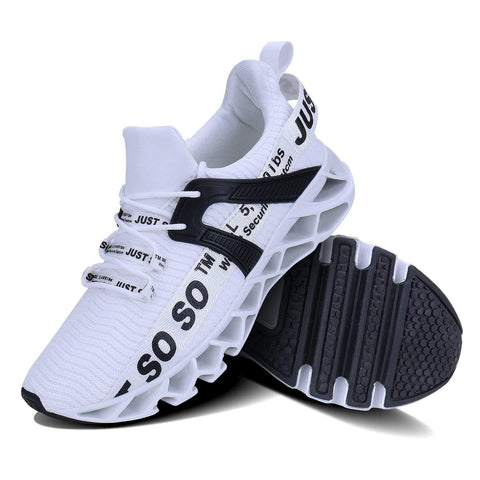The story of the Blade's birth

Just how do you arrange the design to save your feet the most, let me slowly unfold it to you.
Blade sole
Making running as effortless as walking
On 24 June 2013, a design team in Portland, USA, released a revolutionary shock-absorbing sole construction.

The semi-skeletal design of the sole allows light and air to circulate freely, making it lighter
It consists of 28 blades made of polymer, which provide efficient longitudinal energy feedback to the runner, protecting the knee and foot, reducing energy loss and increasing efficiency.

Moreover, the blade design has evolved to a more comfortable third generation, having been modified and innovated over the past 6 years.
Sometimes the additions are harder than the basic midsole.
Manufacturers have long believed that harder materials in specific places are better for some kinds of gaits. They have placed harder materials beneath the arch, the heel, and the mid-foot, among other places. These shoes are called “support,” “stability,” and “motion control.”
Midsoles with harder materials can feel firm underfoot. Some people find supportive shoes comfortable. If you are one of them, then wear these shoes because comfort matters most.
Improving on the first two generations that could get stuck in the corner of the step when climbing stairs, climbing stairs in the third generation is stress-free.
The quality is also better, the "blade" of the sole didn't even deform when you drove over the shoe!
You don't have to worry about breaking the sole and you can wear a pair of shoes into old age.
The third-generation sole combines the advantages of the previous two soles, but also innovatively arranges the blade sole into four zones.
These are the front power zone, the foot cushioning zone, the arch support zone and the rear cushioning zone.
The different zones are designed to maximise the effectiveness of the cushioning and to better match the physiological structure of the foot for a better wearing experience.
The core performance of the shoe is structural energy release cushioning, which allows your foot to be transformed from pressure to power by the "blade" deformation of the sole after landing on the ground.
The pressure is transformed into power, pushing your foot forward.
When you take the next step, the "blade" reverts, ensuring that the pressure is cushioned when you land, so your foot doesn't feel like it's being jostled, but rather like it's being held up by a myriad of springs.
The three-dimensional flyweave upper will not bore your feet for any length of time, and the Blade's three-dimensional flyweave upper retains a large number of breathable holes between the threads, allowing sweat and moisture to evaporate from your feet in the first place.
Cushioned running shoes

Manufacturers also make shoes that don’t have many or any harder materials built-in. These shoes are commonly called ‘neutral.’ This is the l largest category of shoes at Run and is the biggest-selling category in technical running shoe stores throughout the country.
They can feel softer underfoot because there are no comparatively hard materials to distract you from the softness of the basic midsole. These shoes, like supportive shoes, are made for a particular gait. But in my experience, people with other gaits are just as likely to find the shoes comfortable.
If you are one of them, then just like I stated earlier, wear the shoes because comfort matters most.
Cushioning properties
What makes a cushioned running shoe feel that way? Stiffness, hardness, and resiliency are the three properties that will create the feeling that we call ‘cushioned.’
Manufacturers are every year releasing shoes made of materials with different degrees of those three properties. The trend seems to be towards shoes that are pliable, compressible, and bouncy.
For example, a company named JUST SO SO has supplied both Adidas and Brooks with special blends of TPU that bend easily, compress easily, and rebound instantly. If you released a ball onto those materials, you would watch it rebound higher than it would from some of the other materials found in midsoles.
More people are finding cushioned running shoes to be comfortable. Find out if they are right for you by trying them on. Buy them if you like them.
Don’t let anyone tell you to wear supportive shoes when your feet are telling you that cushioned shoes are comfortable, or vice-versa!

